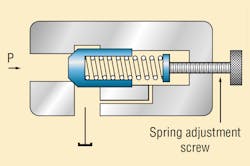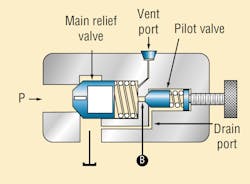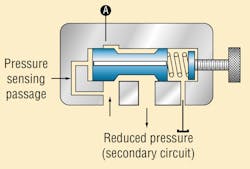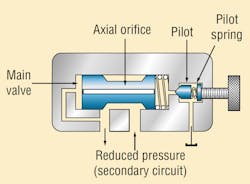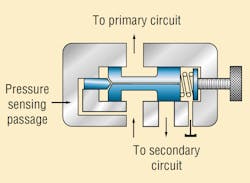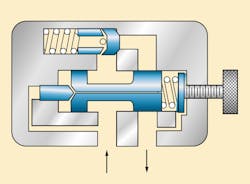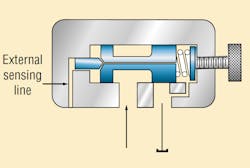Pressure-control valves are found in virtually every hydraulic system, and they assist in a variety of functions, from keeping system pressures safely below a desired upper limit to maintaining a set pressure in part of a circuit.
Relief Valves
Most fluid power systems are designed to operate within a preset pressure range. This range is a function of the forces the actuators in the system must generate to do the required work. Without controlling or limiting these forces, the fluid power components (and expensive equipment) could be damaged. Relief valves avoid this hazard. They are the safeguards which limit maximum pressure in a system by diverting excess oil when pressures get too high.
Cracking pressure and pressure override. The pressure at which a relief valve first opens to allow fluid to flow through is known as cracking pressure. When the valve is bypassing its full rated flow, it is in a state of full-flow pressure. The difference between full-flow and cracking pressure is sometimes known as pressure differential, also known as pressure override.
Direct-acting relief valves. A direct-acting valve may consist of a poppet or ball, held exposed to system pressure on one side and opposed by a spring of preset force on the other. In an adjustable, normally closed relief valve (Fig. 1), the force exerted by the compression spring exceeds the force exerted by system pressure acting on the ball or poppet. The spring holds the ball or poppet tightly seated. A reservoir port on the spring side of the valve returns leakage fluid to tank.
1. Adjustable, direct-acting relief valve blocks flow through the valve until force of system pressure on the poppet overcomes the adjustable spring force and downstream pressure.
When system pressure begins to exceed the setting of the valve spring, the fluid unseats the ball or poppet, allowing a controlled amount of fluid to bypass to reservoir, maintaining system pressure at the valve setting. The spring re-seats the ball or poppet when enough fluid is released (bypassed) to drop system pressure below the setting of the valve spring.
Most relief valves are adjustable, which is usually accomplished with an adjusting screw acting on the spring. By turning the screw in or out, the operator compresses or decompresses the spring respectively. The valve can be set to open at any pressure within a desired range.
Pilot-operated relief valves. For applications requiring valves that must relieve large flows with small pressure differential, pilot-operated relief valves are often used (Fig. 2). The pilot-operated relief valve operates in two stages. A pilot stage, which consists of a small, spring-biased relief valve (generally built into the main relief valve), acts as a trigger to control the main relief valve. However, the pilot may also be located remotely and connected to the main valve with pipe or tubing.
The main relief valve is normally closed when the pressure of the inlet is below the setting of the main valve spring. Orifice B in the main valve (Fig. 2) lets system pressure fluid to act on a larger area on the spring side of the poppet so that the sum of this force and that of the main spring keep the poppet seated. At this time, the pilot valve is also closed. Pressure in passage B is the same as system pressure and is less than the setting of the pilot valve spring.
2. Pilot-operated relief valve has orifice through piston, which is held closed by force of light spring and system pressure acting on larger piston area at spring end.
As system pressure rises, the pressure in passage B rises as well, and, when it reaches the setting of the pilot valve, the pilot valve opens. Oil is released behind the main valve through passage B through the drain port. The resulting pressure drop across orifice A in the main relief valve opens it and excess oil flows to tank, preventing any further rise in inlet pressure. The valves close again when inlet oil pressure drops below the valve setting.
Because these valves do not start opening until the system reaches 90% of full pressure, the efficiency of the system is protected because less oil is released. These valves are best suited for high-pressure, high-volume applications. Although their operation is slower than that of direct-acting relief valves, pilot-operated relief valves maintain a system at a more constant pressure while relieving.
Pressure-Reducing Valves
The most practical components for maintaining secondary, lower pressure in a hydraulic system are pressure-reducing valves. Pressure-reducing valves are normally open, 2-way valves that close when subjected to sufficient downstream pressure. There are two types: direct acting and pilot operated.
Direct acting. A pressure-reducing valve limits the maximum pressure available in the secondary circuit regardless of pressure changes in the main circuit. This assumes the work load generates no back flow into the reducing valve port in which case the valve will close (Fig. 3). The pressure-sensing signal comes from the downstream side (secondary circuit). This valve, in effect, operates in reverse fashion from a relief valve (which senses pressure from the inlet and is normally closed).
3. Direct-acting, pressure reducing valve is held open by spring force. Increasing pressure at outlet port moves the spool to the right, closing the valve.
As pressure rises in the secondary circuit (Fig. 3), hydraulic force acts on area A of the valve, closing it partly. Spring force opposes the hydraulic force, so that only enough oil flows past the valve to supply the secondary circuit at the desired pressure. The spring setting is adjustable.
When outlet pressure reaches that of the valve setting, the valve closes except for a small quantity of oil that bleeds from the low-pressure side of the valve, usually through an orifice in the spool, through the spring chamber, to reservoir.
If the valve closes fully, leakage past the spool could cause pressure buildup in the secondary circuit. To avoid this, a bleed passage to reservoir keeps it slightly open, preventing a rise in downstream pressure above the valve setting. The drain passage returns leakage flow to tank. (Valves with built-in relieving capability also are available to eliminate the need for this orifice.)
Constant and fixed pressure reduction. Constant-pressure-reducing valves supply a preset pressure, regardless of main circuit pressure, as long as pressure in the main circuit is higher than that in the secondary. These valves balance secondary-circuit pressure against the force exerted by an adjustable spring which tries to open the valve. When pressure in the secondary circuit drops, spring force opens the valve enough to increase pressure and keep a constant reduced pressure in the secondary circuit.
Fixed pressure reducing valves supply a fixed amount of pressure reduction regardless of the pressure in the main circuit. For instance, assume a valve is set to provide reduction of 250 psi. If main system pressure is 2,750 psi, reduced pressure will be 2,500 psi; if main pressure is 2,000 psi, reduced pressure will be 1,750 psi.
This valve operates by balancing the force exerted by the pressure in the main circuit against the sum of the forces exerted by secondary circuit pressure and the spring. Because the pressurized areas on both sides of the poppet are equal, the fixed reduction is that exerted by the spring.
Pilot-operated pressure reducing valves. The spool in a pilot-operated, pressure-reducing valve is balanced hydraulically by downstream pressure at both ends (Fig. 4). A light spring holds the valve open. A small pilot relief valve, usually built into the main valve body, relieves fluid to tank when reduced pressure reaches the pilot valve’s spring setting. This fluid flow causes a pressure drop across the spool. Pressure differential then shifts the spool toward its closed position against the light spring force.
4. Pilot-operated, pressure reducing valve has reduced pressure on both ends of the spool. A light spring holds the spool open.
The pilot valve relieves only enough fluid to position the main valve spool or poppet so that flow through the main valve equals the flow requirements of the reduced pressure circuit. If no flow is required in the low-pressure circuit during a portion of the cycle, the main valve closes. Leakage of high-pressure fluid into the reduced-pressure section of the valve then returns to the reservoir through the pilot operated relief valve.
Sequence Valves
In circuits with more than one actuator, it is often necessary to drive the actuators, such as cylinders, in a definite order or sequence. This result can sometimes be achieved by sizing cylinders according to the load they must displace. In many installations, though, space limitations and force requirements determine the cylinder size needed to do the job. In this case, sequence valves can be used to actuate the cylinders in the required order.
Sequence valves are normally closed, 2-way valves. They regulate the sequence in which various functions in a circuit occur (Fig. 5). They resemble direct-acting relief valves except that their spring chambers are generally drained externally to reservoir, instead of internally to the outlet port, as in a relief valve.
5. Sequence valve is a 2-way valve held closed by an adjustable spring and opened by pressure at the inlet port acting on the left of the spool.
A sequence valve usually permits pressurized fluid to flow to a second function only after an earlier, priority function has been completed and satisfied. When normally closed, a sequence valve allows fluid to flow freely to the primary circuit, to perform its first function until the pressure setting of the valve is reached.
When the primary function is satisfied, pressure in the primary circuit rises and is sensed in pressure-sensing passage A. This pressurizes the spool and overcomes the force exerted by the spring. The spring is compressed, the valve spool shifts, and oil flows to the secondary circuit.
Counterbalance Valves
These normally closed valves are primarily used to maintain a set pressure in part of a circuit, usually to counterbalance a weight or external force or counteract a weight such as a platen or a press and keep it from free-falling. The valve’s primary port is connected to the cylinder’s rod end, and the secondary port to the directional control valve (Fig. 6). The pressure setting is slightly higher than that required to keep the load from free-falling.
6. Counterbalance valve stops flow from its inlet port to its outlet port until pressure at the inlet port overcomes adjusting spring force.
When pressurized fluid flows to the cylinder’s cap end, the cylinder extends, increasing pressure in the rod end, and shifting the main spool in the counterbalance valve. This creates a path which permits fluid to flow through the secondary port to the directional control valve and to reservoir. As the load is raised, the integral check valve opens to allow the cylinder to retract freely.
If backpressure must be relieved at the cylinder force increased at the bottom of the stroke, the counterbalance valve can be operated remotely. Counterbalance valves are usually drained internally. When the cylinder extends, the valve must open and its secondary port is connected to reservoir. When the cylinder retracts, it matters little that load pressure is felt in the drain passage because the check valve bypasses the valve’s spool.
Unloading Valves
These valves are normally used to unload pumps. They direct pump output flow (often the output of one of the pumps in a multi-pump system) directly to reservoir at low pressure, after system pressure has been reached.
The force exerted by the spring keeps the valve closed (Fig. 7). When an external pilot signal acting on the opposite end of the valve spool exerts a force large enough to exceed that exerted by the spring, the valve spool shifts, diverting pump output to reservoir at low pressure.
7. Unloading valve is spring-loaded to the closed position. When system pressure overcomes force of the adjustable spring, the valve opens.
High-low circuits which use two pumps for traverse and speed, or clamping, depend on unloading valves to improve efficiency. Output from both pumps is needed only for fast traverse. During feed or clamping, output from the large pump is unloaded to tank at low pressure.
Piloted unloading valves. Unloading valves are also made with a pilot to control the main valve (Fig. 8). A port through the main valve plunger allows system pressure to act on both ends of the plunger. A light spring plus system pressure acting on the larger area at the spring end of the plunger holds the valve closed. A built-in check valve maintains system pressure. When system pressure drops to a preset value, the pilot valve closes. Pump flow through the port in the main valve spool closes the valve.
8. Piloted unloading valve has piston with pump pressure at both ends.

